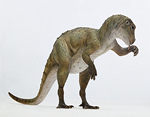Big teeth for a tiny dinosaur
A tiny dinosaur with big canine teeth shows for the first time how one of the earliest dinosaurs grew into an adult, scientists at the Natural History Museum have revealed.

A model of a heterodontosaurus. It was the size of a turkey.
The turkey-sized reptile called Heterodontosaurus lived around 190 million years ago in the Early Jurassic Period and had an unusual combination of molar-like and canine teeth.
Reptiles usually have small same-sized teeth along the length of their mouth but Heterodontosaurus had 2 fang-like canines at the front.
Dinosaur expert at the Museum, Dr Richard Butler, led a team of scientists from London, Cambridge and Chicago. They used CT scans and Xrays to study the fossil uncovered in South Africa.

Adult heterodontosaurus skull from Natural History Museum collections
A tiny 45mm-long fossil skull, from the collections in the South African Museum in Capetown, was identified as a baby Heterodontosaurus by Dr Butler.
Until now, only 2 other specimens of Heterodontosaurus had been found and these were of adults.
This shows that not only the adults but the young had the unusual fang-like teeth too.
'This discovery is important because for the first time we can examine how Heterodontosaurus changed as it grew,' says Dr Butler.

Richard Butler with small dinosaur fossil in plaster
Purpose of the canines
Experts had thought the canines were used by the males for fighting but this find suggests otherwise.
‘The fact the skull of such a young Heterodontosaurus has a fully developed set of canines suggests that they were not restricted to males and used for fighting for territory or females,' Dr Butler adds.

High resolution image of heterodontosaurus skull © Society of Vertebrate Paleontology
'But instead were probably present in both sexes and may have just been used for eating and defence’.
Scientists now believe that rather than eating only plant matter, Heterodontosaurus may have eaten small insects and animals too.
Heterodontosaurus may have been a transitional phase between the earliest meat-eating dinosaurs and the later plant-eating dinosaurs.
Tiny skull smaller than a teabag
The 45mm-long skull specimen was uncovered in South Africa and is less than the size of a teabag. It weighs less than a classic ipod, under 200g, and is one of the smallest dinosaur skulls ever to be discovered.
‘This new discovery has enormous potential to help us understand the evolution of dinosaur diets,’ Dr Butler concludes.
The juvenile Heterodontosaurus skull is held in the collections of the Iziko South African Museum.
The research is published in the Journal of Vertebrate Paleontology.
Toolbox

There are 27 km of specimen shelves in the Darwin Centre - the same distance as between the Museum and Junction 6 of the M1.

